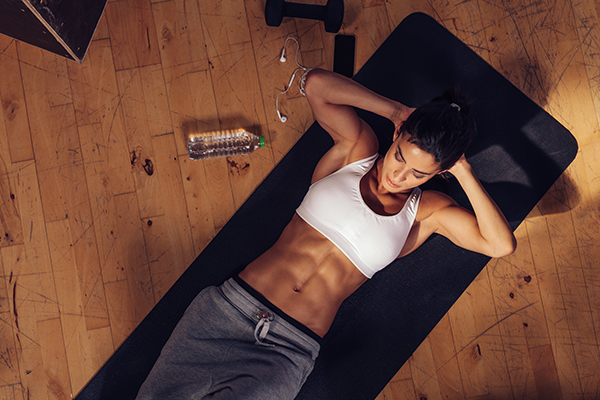By Ritch and Mia Finnegan
Every day we see gimmick exercise equipment, routines and videos advertised as the easy way to get your own “six-pack.” To any true fitness professional, this deceptive advertising is irresponsible and unprofessional. The advertising always seems to talk about getting six-pack abs without mentioning the facts: In order to construct a sculpted waistline, you have to do more than exercise. To get the job done, you also need to use the tools of fat loss, which are nutrition and cardio. Without a healthy diet, you may end up with really well-sculpted abs and obliques lying under a layer of fat. Also, without proper nutrient ingestion, you could train your midsection to perfection, but leave the exhausted muscles starving to death, which in turn means limited recuperation and no results. So, for this project, imagine yourself in the role of an ab-sculpting contractor. For nutrition, check out the Flat Ab Diet. For cardio, perform five to seven 60-minute sessions per week, or try the “Walk This Way” routine below and you’ll be on your way.
Preliminary Pointers
Construction of any type requires tools and the skills to operate them. We will give you the tools and teach you the skills, but it’s up to you to further develop these skills through perfect practice. As we build your routine, here’s some anatomical information and a few basic form skills that will make all the difference.
• The rectus abdominis (six-pack muscle) runs from the bottom of the sternum to the top of the pubic bone. The obliques run from the lower eight ribs to the top of the iliac crest (hip bone), so think about the hips and ribs moving together rather than the head and knees moving together.
• The abs do not cross the hip joint, so visualize the contraction as an accordion compressing rather than a hinge folding.
• Open the rib cage as much as possible for full range of motion.
• Initiate the movement with the abdominal muscles that you are trying to work.
• Exhale completely upon contraction.
• Maintain muscular tension between reps.
Best Ab Exercises
Electromyography (EMG) studies have enabled us to determine which exercises most effectively cause a particular muscle group to fire. Based on that data, we have included a variety of the best ab and oblique exercises. Keep in mind that EMG is used to measure the number of motor units fired and doesn’t measure range of motion, so simply performing the best exercises is only half the game. It’s the quality with which you perform the exercises that matters. So pay close attention to the exercise descriptions. Again, having the tools without the skill makes you an apprentice. Through trial and error you will become a skilled ab and oblique craftswoman.
‘Walk This Way’ Fat-Burning Ab Circuit
If you’re in the mood to feel the burn, then walk this way to a fat-burning ab circuit. Try to keep the pace, but check your heart rate and stay within your target zone. Keep the treadmill incline at 1 percent or less. Your abs will almost fully recover between each ab interval, so make each rep count with good form. Begin with a warm-up and stretch.
Ab interval 1: Bridges, hanging leg raises or Roman chair leg raises, Roman chair oblique raises, bicycles – 1 set of each x 10-15 reps.
Warm-up (5 minutes); speed 3.5
Pick it up (5 minutes); speed 4.0
Race walk (5 minutes); speed 4.5
Recover (2 minutes); speed 3.5
Ab interval 2: Bridges, bicycles, ball crunch (feet wide), hanging leg raises or Roman chair leg raises – 1 set of each x 10-15 reps.
Race walk (5 minutes); speed 4.7
Recover (2 minutes); speed 3.5
Ab interval 3: Roman chair oblique raises, hanging leg raises or Roman chair leg raises, bicycles (same incline), ball crunch (feet close) – 1 set x 10-15 reps.
Race walk (5 minutes); speed 4.5
Recover (2 minutes); speed 3.5
Ab interval 4: Reverse crunch (increase incline), bicycles flat, hanging leg raises or Roman chair leg raises, bicycles flat – 1 set x10-15 reps
Cool down (5 minutes); speed 3.0
Workout Schedule
Beginner/Intermediate: 3 times a week, every other day. Example: Monday-Wednesday-Friday.
Advanced: 4 times week with only two days together. Example: Monday-Tuesday-Thursday-Saturday.
Beginner: 1 set
Intermediate/Advanced: 2-3 sets
Bridges
Sets: 1-3 x Reps: 15-30
Oblique Raises – Roman Chair or Hanging
Sets: 1-3 x Reps: 10-15
Hanging Leg Raises or Roman Chair Leg Raises
Sets: 1-3 x Reps: 10-15
Ball Crunches
Sets: 1-3 x Reps: 10-15
Bicycles
Sets: 1-3 x Reps: 10-15
How to Do the Exercises
Bridges
Start by lying on your left side with your legs and feet together. You should be leaning on your left elbow and forearm (forearm should be perpendicular to the body and flat on ground). Next, raise your hips up off the ground until your body is straight. Maintain a straight line from head to feet. Hold for 15-30 seconds. Switch and repeat. Breathe and focus on the trunk.
Oblique Raises – Roman Chair or Hanging
Start either in a Roman chair, or hanging with hands or ab straps. Start with your knees and legs in a bent position so your thighs are parallel to the ground and your feet are hanging straight down. While exhaling and lifting your hips toward your ribs, twist to one side. Inhale and slowly lower to the start position and repeat on the other side.
Hanging Leg Raises
Take an overhand grip on a pull-up bar with your hands about shoulder-width apart, and allow your body to hang freely. Keeping your legs straight and your toes pointed, exhale and slowly lift your legs upward, avoiding the use of momentum, until your body forms an “L” shape in mid-air. Pause a moment before slowly lowering your legs back to the start.
Roman Chair Leg Raises
Keeping your shoulders down and your back flat, balance your weight evenly between your forearms and allow your body to hang freely inside the machine. Exhale and slowly lift your legs upward, keeping them straight and avoiding the use of momentum, until your body forms an “L” shape in mid-air. Pause a moment before slowly lowering your legs back to the start. Repeat.
Ball Crunches
Lie faceup with a physio ball under your thoracic spine and your hips level with your shoulders. Place your hands across your chest or behind your head as support only. Lower your upper body back around ball for a comfortable stretch. Upon exhaling, contract your abs, raising your torso up until your abs are fully contracted, rounding your ribs toward your hips. Understand the limits of flexibility in your spine; only move through a comfortable range of motion. For more isolation, move feet wider. To recruit more stabilizers and obliques, move your feet closer together.
Bicycles
Start on your back with your legs up and your knees bent. Place your hands behind your head with your elbows out to the side. Simultaneously, move your left knee and right elbow toward each other. While this is happening, your opposite knee and elbow will move away from each other. Remember to lead with your ribs, not your elbows. Focus on your abdominals, bringing your knees in, not your hip flexors. At no time should you pull on your head. Exhale on one side and inhale on the other.
Correct Form for Hanging Leg Raises and Side Bends
Two popular ab exercises are frequently done wrong or are counterproductive. First, 99 percent of the population performs hanging leg raises with the wrong muscle group. Instead of using abs through a full range of motion, many people use their abs isometriclly, with the rectus femoris and illiopsoas (hip flexors) muscles in the front of the thigh used to move the legs up. Consequently, we only recommend traditional hanging straight leg raises for advanced exercisers.
Correct form would include flexion of the spine in an upward motion, not just the legs. (EMG doesn’t distinguish the difference). This is very hard to do when in a hanging position. What you should do is master the motion flat, then at 15 degrees, then 30 degrees, then 45 and so on, until you’re ready for 90. You are much better off using quality form at lower angles. You will feel it more and obtain better results because you’ll be working the muscle through its full range of motion. By the way, the only people we have seen perform this exercise correctly at 90 degrees (hanging) are world-class athletes.
The next no-no: Side bends with or without weights. Remember that when you train obliques, the last thing you want to do is build large muscles. The goal is functionally fit and well-toned muscles. Side bends will leave you with a thick waist and unless you have only 3 percent body fat, it will look like a mini-tire tube of fat.
The post Get Toned, Sculpted Abs and Obliques first appeared on FitnessRX for Women.






